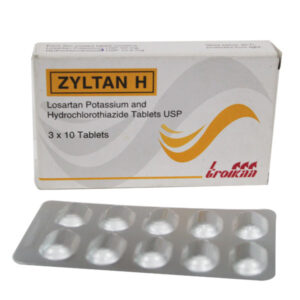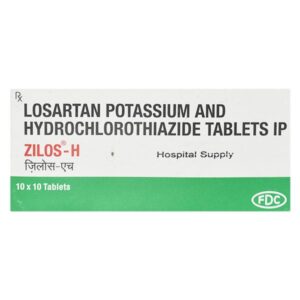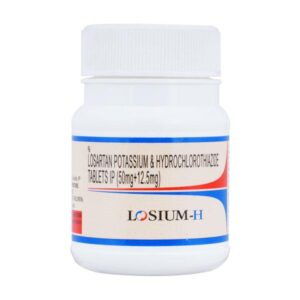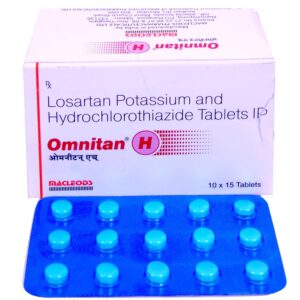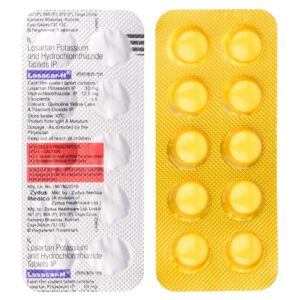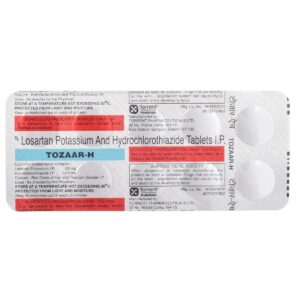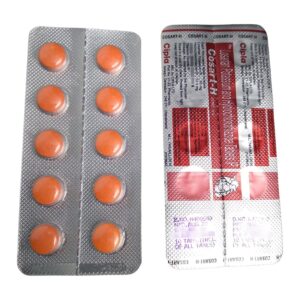LOSARTAN + HYDROCHLOROTHIAZIDE
Losartan: Losartan is a medication that belongs to a class of drugs known as angiotensin II receptor blockers (ARBs). It is commonly prescribed for the treatment of hypertension (high blood pressure) and to protect the kidneys in patients with type 2 diabetes.
The primary mechanism of action of Losartan is the blocking of angiotensin II receptors in the body, preventing the hormone angiotensin II from binding to these receptors. Angiotensin II normally causes blood vessels to narrow and constrict, leading to an increase in blood pressure. By blocking angiotensin II receptors, Losartan allows blood vessels to relax and widen, resulting in a lowering of blood pressure.
The usual starting dose of Losartan for the treatment of hypertension is 50 mg once daily. However, the dosage may be adjusted based on individual response and the condition being treated. It can be taken with or without food.
Some common side effects of Losartan include dizziness, headache, fatigue, low blood pressure, increased potassium levels, cough, and upper respiratory tract infections. It is also advised to inform your healthcare provider if you experience any signs of an allergic reaction such as rash, itching, swelling, severe dizziness, or difficulty breathing.
It is important to note that Losartan may interact with other medications, especially drugs that increase potassium levels or affect the renin-angiotensin system, such as other blood pressure medications. Therefore, it is essential to inform your doctor about all the medications, supplements, and herbs you are currently taking.
Overall, Losartan is a commonly used medication for treating hypertension and protecting the kidneys in diabetic individuals. It is important to follow the prescribed dosage and consult with a healthcare professional for personalized advice and management of any potential side effects.
Hydrochlorothiazide: Hydrochlorothiazide (HCTZ) is a diuretic medication commonly prescribed to treat high blood pressure (hypertension) and edema (fluid retention). It works by increasing the amount of urine produced by the kidneys, aiding in the elimination of excess salt and water from the body.
The exact mechanism of action of hydrochlorothiazide is not fully understood, but it primarily acts on the distal convoluted tubules of the kidneys. It inhibits the reabsorption of sodium and chloride ions, leading to increased excretion of these ions and the accompanying water. This ultimately results in a decrease in blood volume, which helps to lower blood pressure.
The typical starting dose of hydrochlorothiazide for hypertension is 12.5 to 25 milligrams once daily. This may be increased up to a maximum of 50 mg per day, depending on the individual’s response and the severity of the condition. For edema, the initial dose is usually 25 to 100 mg daily, with the dosage adjusted as necessary.
As with any medication, hydrochlorothiazide can cause side effects. Common side effects include frequent urination, dizziness, headache, stomach upset, and low potassium levels (hypokalemia) in the blood. It may also lead to increased levels of uric acid, resulting in gout attacks for some individuals. In rare cases, serious side effects such as allergic reactions, electrolyte imbalances, and kidney problems may occur.
It is important to note that hydrochlorothiazide should be used cautiously in individuals with pre-existing medical conditions such as renal impairment, liver disease, diabetes, or gout. Additionally, it can interact with other medications, including but not limited to, NSAIDs, lithium, certain antidiabetic drugs, and digoxin. Therefore, it is crucial to inform your healthcare provider about all the medications you are taking to avoid potential drug interactions.
Overall, hydrochlorothiazide is a commonly prescribed diuretic used to treat hypertension and edema. It helps to lower blood pressure by increasing urine production and eliminating excess salt and water. However, it is important to be aware of potential side effects and drug interactions associated with its use, and always follow the prescribed dose and recommendations of your healthcare provider.

